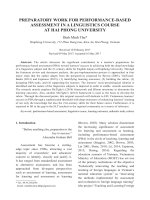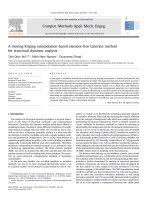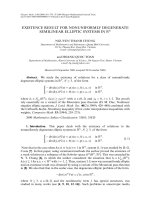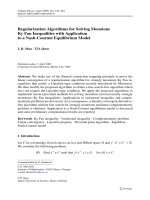DSpace at VNU: A consideration for developing a dry port system in Indochina area
Bạn đang xem bản rút gọn của tài liệu. Xem và tải ngay bản đầy đủ của tài liệu tại đây (1.75 MB, 11 trang )
This article was downloaded by: [Selcuk Universitesi]
On: 02 January 2015, At: 19:08
Publisher: Routledge
Informa Ltd Registered in England and Wales Registered Number: 1072954 Registered
office: Mortimer House, 37-41 Mortimer Street, London W1T 3JH, UK
Maritime Policy & Management: The
flagship journal of international
shipping and port research
Publication details, including instructions for authors and
subscription information:
/>
A consideration for developing a dry
port system in Indochina area
a
a
Ngoc-Hien Do , Ki-Chan Nam & Quynh-Lam Ngoc Le
b
a
Department of Logistics , Korea Maritime University , #1
Dongsam-dong, Yeongdo-gu, Busan, Korea
b
Department of Industrial Systems Engineering , Ho Chi Minh City
University of Technology , 268 Ly Thuong Kiet Street, District 10,
Ho Chi Minh City, Vietnam
Published online: 10 Jan 2011.
To cite this article: Ngoc-Hien Do , Ki-Chan Nam & Quynh-Lam Ngoc Le (2011) A consideration
for developing a dry port system in Indochina area, Maritime Policy & Management: The flagship
journal of international shipping and port research, 38:1, 1-9, DOI: 10.1080/03088839.2010.533712
To link to this article: />
PLEASE SCROLL DOWN FOR ARTICLE
Taylor & Francis makes every effort to ensure the accuracy of all the information (the
“Content”) contained in the publications on our platform. However, Taylor & Francis,
our agents, and our licensors make no representations or warranties whatsoever as to
the accuracy, completeness, or suitability for any purpose of the Content. Any opinions
and views expressed in this publication are the opinions and views of the authors,
and are not the views of or endorsed by Taylor & Francis. The accuracy of the Content
should not be relied upon and should be independently verified with primary sources
of information. Taylor and Francis shall not be liable for any losses, actions, claims,
proceedings, demands, costs, expenses, damages, and other liabilities whatsoever or
howsoever caused arising directly or indirectly in connection with, in relation to or arising
out of the use of the Content.
This article may be used for research, teaching, and private study purposes. Any
substantial or systematic reproduction, redistribution, reselling, loan, sub-licensing,
systematic supply, or distribution in any form to anyone is expressly forbidden. Terms &
Downloaded by [Selcuk Universitesi] at 19:08 02 January 2015
Conditions of access and use can be found at />
MARIT. POL. MGMT., JANUARY
VOL.
38,
NO.
2011,
1, 1–9
A consideration for developing a dry port system
in Indochina area
NGOC-HIEN DO*y, KI-CHAN NAMy and
QUYNH-LAM NGOC LEz
Downloaded by [Selcuk Universitesi] at 19:08 02 January 2015
yDepartment of Logistics, Korea Maritime University,
#1 Dongsam-dong, Yeongdo-gu, Busan, Korea
zDepartment of Industrial Systems Engineering, Ho Chi Minh City
University of Technology, 268 Ly Thuong Kiet Street, District 10,
Ho Chi Minh City, Vietnam
Dry ports are intermodal transport hubs in the inland, which operate as centres
for the transshipment of sea cargo to inland destinations. They could make the
import and export easier and increase trade. This paper considers conditions to
construct them in the Indochina area including three countries Vietnam, Lao
People’s Democratic Republic (Laos) and Cambodia. Accordingly, the general
characteristics of dry ports and the conditions to develop them are reviewed.
Transportation systems in the Indochina area are then analysed. Consequently, a
suggested dry port system is presented, which promises to bring many benefits for
the Indochina region. Finally, some conclusions and suggestions are presented.
1. Introduction
In the globalization of the economy, nations’ economies need to be transformed as a
result of many global demand and supply forces not only in manufacturing industries
but also in all economic sectors including the services sector. Industry expects an
effective and efficient transport system to support sustainable economic growth and
enable it to compete in national, regional and global market. It could ensure that
products reach the markets quickly, efficiently and in good condition.
A good transportation system is an important factor attracting foreign investment
to any economy. With it, firms have the ability to respond to changing customer
demand faster and reduce their costs, so their competitive advantage is increased.
Obviously, the transportation system plays a very important role in a nation’s
economic growth, and therefore much attention should be paid to its development.
However, to establish a good transportation system is not easy. It depends on many
conditions such as the nation’s economy, policy, requirements and geographical
features.
Indochina area is located in Southeast Asia. It occupies the easternmost region of
the Indochinese peninsula, on land located directly east of Thailand and south
of China, which is comprises three countries, Vietnam, Laos and Cambodia [1].
The Indochina area has good conditions to develop its economy. The three countries
are members of Association of Southeast Asian Nations (ASEAN). In addition, the
Indochina area shares borders with China, one of the biggest markets in the world, is
*To whom correspondence should be addressed. E-mail:
Maritime Policy & Management ISSN 0308–8839 print/ISSN 1464–5254 online ß 2011 Taylor & Francis
/>DOI: 10.1080/03088839.2010.533712
Downloaded by [Selcuk Universitesi] at 19:08 02 January 2015
2
N.-H. Do et al.
located on the international marine transport network, and has a good relationship
with China. However, currently, this region has been considered as a weak economic
zone [2].
Underdeveloped transportation infrastructure which cannot create a strong
support for economic growth is one of reasons why the economic zone is developing
slowly. Each country has its own characteristics with advantages and disadvantages
to develop its transportation system. Laos has borders with two big markets,
Thailand and China, but it is a landlocked country, so it is difficult to use marine
transport. Cambodia has a seaport system, but it is weak. Vietnam has a long coast
line with suitable conditions for developing a good seaport system and has a border
with China, but its seaport system could not compete with neighbour ports such as
port of Singapore, Thailand and Malaysia. Therefore, it is difficult for them to
construct an efficient and effective transportation system if they do not have a good
cooperative plan.
Dry port system could be considered as an alternative to improve the
transportation system in this region. Dry ports could be inland terminals within a
country that has a gateway port or they could be located in adjacent landlocked
countries in the hinterland of one or more seaports [3]. Dry port supplies regions
with an intermodal terminal or a merging point for traffic modes—rail, air and truck
routes—involved in distributing merchandise that comes from water ports [4]. It can
operate as an extension to an existing seaport, increasing capacity and efficiency and
also moving traffic off the roads and onto rail or inland waterways, wherever
possible. Therefore, it could support port capacity by improving hinterland
distribution hubs and looking at the potential of inland port with multimodal
connections.
This paper analyses Indochina’s conditions for developing a suitable dry port
system. The transportation infrastructure including the road network with Asian
Highway system, railway with Singapore–Kunming rail link (SKRL) and seaport
system is reviewed. Especially, a deep look on key seaports in this area is given.
Based on them, alternatives for developing a dry port system are suggested. Finally,
some conclusions and suggestions are proposed.
2. Conditions for developing a dry port system
The economic cooperation programme started by the Asian Development Bank
attempts to facilitate economic cooperation not only through hard infrastructure
development but also through cross-border transportation agreements among
countries. Vietnam, Laos, Cambodia, Thailand and other Asian countries concluded
an agreement for facilitation of cross-border transport of goods and people in 1999
[5]. It gives many advantages on development of cross-border transport infrastructure and facilitation of border crossing procedures not only in the Indochina region
but also in Asia. It, therefore, promises to improve investment environment and
develop new logistics route, and result in growth of trade development of regional
economy.
The Asian Land Transport Infrastructure Development project comprising the
Asian Highway and the Trans-Asian Railway network as well as facilitation of land
transport was endorsed by the United Nations Economic and Social Commission for
Asia and the Pacific in 1992 [6]. It could promote regional cooperation, maximize use
Downloaded by [Selcuk Universitesi] at 19:08 02 January 2015
Developing a dry port system in Indochina area
Figure 1.
3
A part of Asian Highway in Southeast Asia.
Source: UNESCAP [6].
of existing infrastructure and make a coordinated plan for development. Indochina
sub-region transport network is a part of this project.
Vietnam, Laos, Cambodia and other countries comprise in the Southeast Asian
sub-region which has more than 23 400 km of Asian Highway [6] as shown in
Figure 1. The total Asian Highway length in Indochina area is only 6396 km or
approximately 27%. It connects primary economic centres and national roads.
Therefore, it could contribute in the international transport network not only of this
region but also of Asia.
Besides, in 2006, a transportation agreement by 18 transport ministers in
connection with the Trans-Asia Railway Network (TAR) was reached, which started
off the United Nations project to connect the Far East to Western Europe by rail
link [7]. The Singapore-Kunming Rail Link (SKRL), as shown in Figure 2, is a subproject in Southeast Asia, which spans around 5000 km from Singapore through
Indochina area to the Kunming City, China. It is a very efficient and economic mode
of cross-border cargo transportation [8]. There are six alternative routes to link
Singapore to Kunming as shown in Table 1. Route 1 connecting Vietnam, Laos,
Cambodia and China is evaluated at its high social and economic impact by the
ASEAN Transport Ministers [9]. Laos, a landlocked country, could access the
world’s markets through TAR or efficient rail links to international ports.
Similar to highway or railway network, the ASEAN-wide port system was
proposed in 1999, which consisted of 47 ports as shown in Figure 3. It is easy to
recognize that Indochina’s ports could not compare with neighbour ports in the
ASEAN region, such as ports of Malaysia, Thailand, Indonesia and the Philippines.
N.-H. Do et al.
Downloaded by [Selcuk Universitesi] at 19:08 02 January 2015
4
Figure 2.
The Singapore–Kunming Rail Link network.
Source: ASEAN [9].
Although it has a long coast, mainly in Vietnam, and is located near international
maritime transport network, there is no hub port in this region. However, seaports’
roles can shift from one to the other depending on the growth of the world trade
carried in containers, the shipping pattern, the bargaining powers of the port users
and port service providers as well as competition itself in the region [11], and
therefore whether seaports in Indochina area could become hub port(s) or
international transit port(s).
Developing a dry port system in Indochina area
Table 1.
Study
route
Route
Route
Route
Route
Route
Route
5
Route alternatives for SKRL project.
Total capital outlay
(US$ billions)
Route
distance (km)
Missing
links (km)
Countries involved
1.8
6.0
1.1
5.7
1.1
1.1
5382
4559
4259
4164
4481
4225
431
1127
531
1300
616
589
Cambodia, Laos PDR, Vietnam
Myanmar, Thailand, China
Laos PDR, Vietnam
Laos PDR, China
Laos PDR, Vietnam, Thailand
Laos PDR, Vietnam, Thailand
1
2
3
4
5
6
Downloaded by [Selcuk Universitesi] at 19:08 02 January 2015
Source: ASEAN [9].
Figure 3. ASEAN port network system.
Source: ALMEC Corporation [10].
3. Seaport systems
As mentioned above, Laos is a landlocked country, so transportation of freight or
people directly in the maritime way is impossible. It has exported and imported
goods mainly through the Laem Chabang Port in Thailand, so Thailand is the
biggest trading partner of Laos. An alternative route that could serve as access from
Laos to ports of Vietnam can handle its export or import. Because of the bilateral
agreement with Vietnam [12], there is no need for transshipment at the border.
6
N.-H. Do et al.
Table 2.
General characteristics of four main Vietnamese ports.
Downloaded by [Selcuk Universitesi] at 19:08 02 January 2015
Port
Hai Phong
Lach Huyen
Dinh Vu
Cai Lan
Da Nang
Tien Sa, Son Tra
Lien Chieu
Ba Ria–Vung Tau
Cai Mep, Sao Mai – Ben Dinh
Phu My, My Xuan
Long Son
Van Phong, Khanh Hoa
Dam Mon
South Van Phong
West Van Phong
Accommodated ship
50 000–80 000 DWT or 4000–6000 TEU
20 000–30 000 DWT
50 000 DWT or 3000 TEU
30 000–50 000 DWT or 4000 TEU
50 000–80 000 DWT or 4000–6000 TEU
80 000–100 000 DWT or 6000–8000 TEU
50 000–80 000 DWT or 4000–6000 TEU
30 000 DWT
9000–15 000 TEU
400 000 DWT
50 000–100 000 DWT
Source: Vietnamese President Officer [14].
Cambodia has three main international ports, in which Sihanoukville is its main
deep seaport. Its capacity is estimated to be around 1 million tons a year. Because of
the rocky outcrops in the channel, the entrance to the port is restricted to vessels with
a draft of less than 8.0–8.5 m, which could accommodate ships of 10 000–15 000
DWT (source: Sihanoukville Autonomous Port of Cambodia, [13]). However, it
could not become a hub port for Indochina region due to its disadvantages.
Thanks to geographic conditions, Vietnam has many deep water seaports located
on the long coast, approximately 3200 km, in which Hai Phong, Da Nang and Ba
Ria–Vung Tau ports have been considered to develop as international maritime
gateways and especially the Van Phong–Khanh Hoa port has been developed to
become the international transit port not only for Vietnam but also for Indochina
and ASEAN region [14]. Their main characteristics are summarized in Table 2.
However, all ports in the Indochina region have been considered as feeder ports as
shown in Figure 3, although some ports, especially Vietnamese ports, meet the
required conditions to become international hub ports or transit ports.
Van Phong port, for example, is located on the farthest east of the Indochina
region, which is the closest point of the international marine lines, ASEAN–Manila–
Guam–Honolulu–San Francisco, Victoria or Panama. In comparison with Hong
Kong and Singapore ports, the shortest marine line transporting to America is from
Van Phong port [15]. Besides, it has good natural conditions required for developing
ports and a conducive policy for investment from Vietnamese Government.
4. Dry port system as an improvement alternative
Although the Indochina region has been participating in Asian Highway, Railway
Links Network and ASEAN-wide Port System project, its transportation system is
not considered as an effective and efficient one. It is essential for effective regional
integration and efficient supply chain if an effective and efficient transport network is
set up. Significant progress has been made in improving connectivity and intermodal
Downloaded by [Selcuk Universitesi] at 19:08 02 January 2015
Developing a dry port system in Indochina area
7
facilities such as ports and dry ports or Inland Container Depots (ICD) not only in
Indochina but also in the Asia Pacific region. The region has realized the importance
of such improvements, as evidenced by the efforts being undertaken to connect the
different modes to each other and to improve their capacities.
Dry ports play an important role in integrating modes of transport, reducing
border crossing and transit delays, facilitating the use of energy efficient and lower
emission means of transport, and creating new clusters of economic growth and job
creation in the local area [16]. A dry port is a hinterland intermodal freight transport
hub, typically providing valuable space for logistics and onward distribution
activities [17]. The potential benefits of dry ports would be seen if they are applied
successfully.
Depending on a specific transportation system where the necessary supporting
infrastructure such as roads and railways is assured and the regulatory and
institutional systems are properly designed to optimize the involvement of both the
public and the private sector, a suitable dry port is designed and applied.
Accordingly, considerable dry ports fitting into the Indochina region are suggested
as shown in Figure 4.
There are three dry port categories: close, midrange and distant [18], based upon
the function and the location. Each of them has its own benefits defined from the
perspectives of actors involved, such as seaports, rail and road operators, shipping
lines, shippers, local authorities and society. There are already good dry ports in the
Indochina region, which could be considered as models for others. For example, a
dry port located next to the Phnom Penh capital city near the national highway and
the railroad is an ideal cargo staging area and distribution point. As most
forwarders, importers and exporters are located in Phnom Penh, the transportation
cost and time are drastically reduced in using this dry port instead of Sihanoukville
Autonomous Port which is 230 km away. Another example is the close dry port
system in Ho Chi Minh City ports of Vietnam, such as Tan Cang–Song Than
ICD, Transimex ICD, Tanamexco ICD and Ben Nghe ICD. At present, they serve
for Ho Chi Minh port as close dry ports, but in the near future when the city ports
move away to Ba Ria–Vung Tau they could be considered as midrange dry ports
for them.
Most existing dry ports are domestic ones that serve for local ports. It is possible
to enhance this system and to set up suitable dry ports at international gateways.
They promise generating a good transportation system for this region in order to
enjoy benefits of intermodal transportation. Especially, importers or exporters to/
from Laos would be attracted due to the advantages of this system. Distant dry ports
could be constructed at Laos’ economic centres such as Vientiane and linked directly
to Vietnamese seaports by railways. As a result, Vietnamese seaports would have an
extended hinterland.
Indochina dry ports could make a strong connection to gateway regions. As a
result, increase in trade flows, lower door-to-door freight rates, avoidance of clearing
and forwarding agent’s fees and seaports, storage demurrage and late documentation
fees, the need to extend the period of marine insurance, optimal use of road and rail
transport and national rolling stock, better utilization of capacity, greater use of
containers, lower customs staff costs, benefits to seaports, inventory savings, benefits
of unit trains, improved communications and additional benefits could be brought
by the dry port system.
N.-H. Do et al.
Downloaded by [Selcuk Universitesi] at 19:08 02 January 2015
8
Figure 4.
Suggested dry port system for Indochina region.
5. Conclusions
A successful dry port system could support Indochina seaport capacity by improving
hinterland distribution hubs and looking at the potential of inland ports with
multimodal connections. Consequently, it could help change the situation better not
only of regional seaports with ambitions to become international hub port(s) and
transit port(s) in the shortest possible time but also of regional effective and efficient
transportation system.
In developing efficient intermodal transportation, member countries should
continue to invest in upgrading roads, modernizing ports and constructing dry ports
as well as the provision of sufficient cargo/container handling equipment and the
Developing a dry port system in Indochina area
9
streamlining of clearance procedures. The development of the intermodal facilities
and networks requires large investments. Government resources are often not
sufficient to meet such requirements. Therefore, countries need to explore different
funding options including public–private partnerships, development assistance and
loans from financing institutions.
References
1.
2.
Downloaded by [Selcuk Universitesi] at 19:08 02 January 2015
3.
4.
5.
6.
7.
8.
9.
10.
11.
12.
13.
14.
15.
16.
17.
18.
FONTAINE, H. and WORKMAN, D. R., 1998, Indochina: Region review. In: Encyclopedia of
European and Asian Regional Geology, edited by E. M. Moores and R. W. Fairbridge
(Berlin, Heidelberg: Springer), pp. 372–376.
NEMOTO, T., 2009, Planning framework for international freight transportation
infrastructure: A case study on the east-west economic corridor in the greater Mekong
subregion. The Asian journal of shipping and logistics, 25(2), 253–271.
UNITED NATIONS CONFERENCE ON TRADE AND DEVELOPMENT (UNCTAD), 1991,
Handbook on the Management and Operation of Dry Ports (Geneva: UNCTAD).
ROSO, V., 2005, The dry port concept – applications in Sweden. In Proceedings of
Logistics Research Network: International Logistics and Supply Chain Management,
September 7–9, Plymouth, UK, pp. 379–382.
JICA and ALMEC, 2007, The research on the cross border transportation infrastructure.
/>UNITED NATIONS ECONOMIC AND SOCIAL COMMISSION FOR ASIA AND THE PACIFIC
(UNESCAP), 2006, Priority Investment Needs for the Development of the Asian
Highway Network (New York: United Nations). />detail.asp?id=1195
UNITED NATIONS ECONOMIC AND SOCIAL COMMISSION FOR ASIA AND THE PACIFIC
(UNESCAP), 2006, Development of the Trans-Asian Railway, Trans-Asian Railway in
the North-South Corridor–Northern Europe to the Persian Gulf.
UNITED NATIONS ECONOMIC AND SOCIAL COMMISSION FOR ASIA AND THE PACIFIC
(UNESCAP), 1996, Economic and Social Commission for Asia and the Pacific:
Trans-Asian Railway Route Requirements—Development of the Trans-Asian Railway in
the Indo-china and ASEAN Subregion, Vol. 1.
ASEAN, 2007, The Singapore-Kunming Rail Link project, Fact sheet.
ALMEC CORPORATION, 2002, ASEAN Maritime Transport Development Study, Final
Report Summary, November.
UNCTAD, 2009, Transport Newsletter, No. 43, Second and Third Quarters 2009.
THE LAO PDR, THAILAND AND VIETNAM, 1999, Agreement between and among the
Governments of the Lao People’s Democratic Republic, the Kingdom of Thailand, and the
Socialist Republic of Vietnam for Facilitation of Cross-border Transport of Goods and
People.
PAS, 2007, Introduction of Sihanoukville Autonous Port. />introduction.html
VIETNAMESE PRESIDENT OFFICER, 2009, Agreement about planning for developing
Vietnamese seaport system until 2020 and orientation to 2030.
CHU, Q. T., 2002, Van Phong: The prospect of new century, Khanh Hoa, Vietnam.
/>F003013A3/index.html
UNESCAP, 2009, Review of Developments in Transport in Asia and Pacific (New York:
United Nations). www.unescap.org/ttdw/review/files/review2009.pdf
NOTTEBOOM, T., 2009, Why do we need dry ports? Some experiences from Europe.
Special Session of the International Forum on Shipping, Ports and Airports (IFSPA),
Hong Kong, China, May.
ROSO, V., WOXENIUS, J. and LUMSDEN, K., 2009, The dry port concept: connecting
container seaports with the hinterland. Journal of Transport Geography, 17, 338–345.









